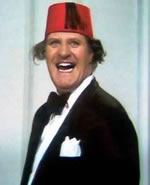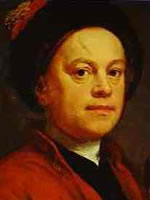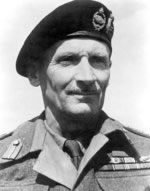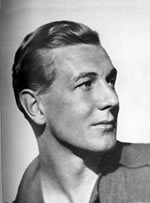From Tommy Cooper to William Butler Yeats
Local Historian Gillian Clegg On Some of Chiswick's Most Noted Residents
TOMMY COOPER
Comic genius Tommy Cooper (1922-1984) lived in Chiswick for almost 30 years. He moved into 51 Barrowgate Road in 1955 and was living there when he collapsed with a heart attack during a performance at Her Majesty’s Theatre, dying on his way to hospital. Famous for his catchphrase `Just like that’, and his bumbling magic tricks (he was actually an accomplished magician and a member of the Magic Circle), Cooper began his career during World War II, entertaining the troops while serving in the Middle East. It was here he acquired his trademark fez – by accident. Unable to find his pith helmet before a performance he borrowed a waiter’s fez, stuck it on his head and walked on stage to roars of laughter.
almost 30 years. He moved into 51 Barrowgate Road in 1955 and was living there when he collapsed with a heart attack during a performance at Her Majesty’s Theatre, dying on his way to hospital. Famous for his catchphrase `Just like that’, and his bumbling magic tricks (he was actually an accomplished magician and a member of the Magic Circle), Cooper began his career during World War II, entertaining the troops while serving in the Middle East. It was here he acquired his trademark fez – by accident. Unable to find his pith helmet before a performance he borrowed a waiter’s fez, stuck it on his head and walked on stage to roars of laughter.
EM FORSTER
Author and critic Edward Morgan Forster (1879-1970 maintained a pied a terre at 9 Arlington Mansions, Sutton Lane from 1939 until his death. Forster, a member of the Bloomsbury Group and a friend of Virginia Woolf, is best known for novels such as A Passage to India and Howard’s End but for the last 46 years of his life he eschewed novel writing and published short stories and non-fiction. Forster hid his personal life from the public gaze but he is known to have had a relationship with a London policeman and he wrote a novel with a homosexual theme, Maurice, which was not published until after his death.
WILLIAM HOGARTH
 Chiswick’s most famous resident is William Hogarth (1697-1764) who, in 1749, bought his `little country box by the Thames’ in what became known as Hogarth Lane (now part of the A4) and spent the greater part of each summer there. Hogarth is best known for his pictorial satires of 18th-century life such as A Rake’s Progess and Marriage a La Mode which were produced as engraved prints which made them relatively inexpensive to purchase.
Chiswick’s most famous resident is William Hogarth (1697-1764) who, in 1749, bought his `little country box by the Thames’ in what became known as Hogarth Lane (now part of the A4) and spent the greater part of each summer there. Hogarth is best known for his pictorial satires of 18th-century life such as A Rake’s Progess and Marriage a La Mode which were produced as engraved prints which made them relatively inexpensive to purchase.
Hogarth was a quintessentially English painter who wanted to establish a native style of English art and improve the status of English artists. As such he was out of step with the aesthetic preferences of the time which harked back to Classical themes. Hogarth’s fiercely independent, cocky and belligerent nature made him many enemies but he had a softer side – he loved animals and children and was one of the founder-governors of the Foundling Hospital in Bloomsbury, established by philanthropist Thomas Coram.
Hogarth is buried in the churchyard of St Nicholas under a tombstone with an epitaph written by actor David Garrick.
Hogarth’s house was saved from demolition in 1901 when it was purchased by local resident Lt Col Robert Shipway. Shipway opened it to the public in 1904 as a Hogarth museum and later conveyed the house to Middlesex County Council and it was transferred to the London Borough of Hounslow in 1965.
NANCY MITFORD
Nancy Mitford (1904-73) was the eldest daughter of 2nd Baron Redesdale and one of the noted Mitford sisters. She wrote articles, biographies and novels, notably Noblesse Oblige and Love in a Cold Climate. Between 1934 and 1936 she lived at 84 Strand-on-the-Green while she was married to the Hon Peter Rodd and working in a bookshop. Her writing, combined with clever investments on the Stock Exchange, made her wealthy and after her divorce she moved to Paris where she lived the highlife among the French and Italian aristocracy.
VISCOUNT MONTGOMERY
 Field Marshal Bernard Law Montgomery (1887-1976), later Viscount Montgomery of Alamein, spent part of his childhood at 19 Bolton Road, Grove Park, a house rented by his father. Montgomery obtained a commission in the regular army before the outbreak of World War I and lived a bachelor existence until the age of 40 when he married the widowed artist Betty Carver, who lived on Chiswick Mall, in St Nicholas Church.
Field Marshal Bernard Law Montgomery (1887-1976), later Viscount Montgomery of Alamein, spent part of his childhood at 19 Bolton Road, Grove Park, a house rented by his father. Montgomery obtained a commission in the regular army before the outbreak of World War I and lived a bachelor existence until the age of 40 when he married the widowed artist Betty Carver, who lived on Chiswick Mall, in St Nicholas Church.
Following his marriage he was posted to India where his son David was born and where Betty died from a mysterious illness. During World War II Winston Churchill appointed Montgomery the general commanding the Eighth Army in Egypt. The Battle of Alamein was the first of his many victories. He was promoted to the rank of Field Marshall and became a popular hero. In 1945 Montgomery was awarded the freedom of the Borough of Brentford and Chiswick at a ceremony in the Chiswick Empire, following a procession along the High Road from Young’s Corner.
LUCIEN PISSARRO
Lucien Pissarro (1863-1944), the eldest son of French artist Camille Pissarro moved to 62 Bath Road in 1897 and, in 1902, to The Brook, Stamford Brook. In 1897 Camille came to visit his son and during the two months he stayed produced seven oil paintings of Stamford Brook. Lucien was an artist who painted many scenes in west London. He was also a wood engraver and a printer and is perhaps best known for founding the Eragny Press which produced exquisite little hand-printed books. Lucien was a short, shy, softly-spoken man with a very large beard. However, the Pissarros were very hospitable giving regular soirees for their friends from the art world.
ALEXANDER POPE
The poet, essayist and writer Alexander Pope (1688-1744) lived with his parents in Mawson Row, Chiswick between 1716 and 1719. The house where he lived now contains the Mawson Arms pub. Some of Pope’s original translation of the Iliad was drafted on the backs of letters addressed to `Mr Pope’ at his house in `ye New Buildings, Chiswick’. In 1719 Pope moved to his villa in Twickenham where he constructed a celebrated grotto. Due to a childhood illness Pope was diminutive and disabled. He never married but had many friends including Lord Burlington of Chiswick House to whom he dedicated his essay entitled On Taste. However, since Pope was a quarrelsome fellow he also made many enemies among the literary fraternity.
MICHAEL REDGRAVE
 Actor Michael Redgrave (1908-1985) bought Bedford House in Chiswick Mall in 1945. With his wife Rachel Kempson and children Vanessa, Lyn and Corin, he lived there until 1954.
Actor Michael Redgrave (1908-1985) bought Bedford House in Chiswick Mall in 1945. With his wife Rachel Kempson and children Vanessa, Lyn and Corin, he lived there until 1954.
Redgrave had been a schoolteacher before his illustrious career on the stage, involving seasons at the Old Vic, Stratford and Chichester. He also appeared in about 50 films, becoming popular after his leading role in Hitchcock’s The Lady Vanishes (1938).
A tall and imposing figure he was articulate about the craft of acting, writing two books on the subject.
WILLIAM BUTLER YEATS
Poet and playwright William Butler Yeats (1865-1939), winner of the 1923 Nobel Prize in Literature, lived at two addresses in Bedford Park. In 1876 his father, the artist John Butler Yeats, moved his wife and six children to No 8 Woodstock Road. In about 1880 the family moved away but returned in 1888 to 3 Blenheim Road where William remained until about 1894. It was while living in Bedford Park that Yeats composed his best-known poem The Lake Isle of Innisfree and met Maud Gonne, the woman who was to be the object of his unrequited passion and an important influence on his writing. Yeats described the meeting as the day `the troubling of my life began’. He proposed to her several times but was always refused.
JOHANN ZOFFANY
The German-born artist Johann Zoffany (1733-1810) arrived in England in 1760 to seek his fortune. His arrival co-incided with George III’s accession to the throne and the patronage of George’s German queen, Charlotte of Mecklenburg-Strelitz, enabled Zoffany to become one of the most fashionable artists of the day. In 1764 he rented London Style House, a large house on the banks of the Thames by Kew Bridge. In 1772 Zoffany went abroad but on his return in 1789 he bought 65 Strand-on-the-Green. Zoffany was extravagant, flamboyant and entertained lavishly. Consequently he was frequently in debt. He may also have been a bigamist as no evidence has come to light to show that his first wife was dead before he married for the second time.
Zoffany painted two altar pieces as gifts for local churches. He used local fishermen as models for the apostles for his painting of The Last Supper. Tradition has it that he painted himself as St Peter and that the model for Judas was a lawyer he had fallen out with. He offered the painting to St Ann’s Church Kew but the church refused to accept it and instead it went to St George’s Church, Brentford (it now hangs in St Paul’s Church, Brentford). The altar piece he painted for St Nicholas Church was sold at Christies in 1904.
Written by Gillian Clegg and reproduced with kind the permission of Open Chiswick.
June 22, 2007
Related links
|